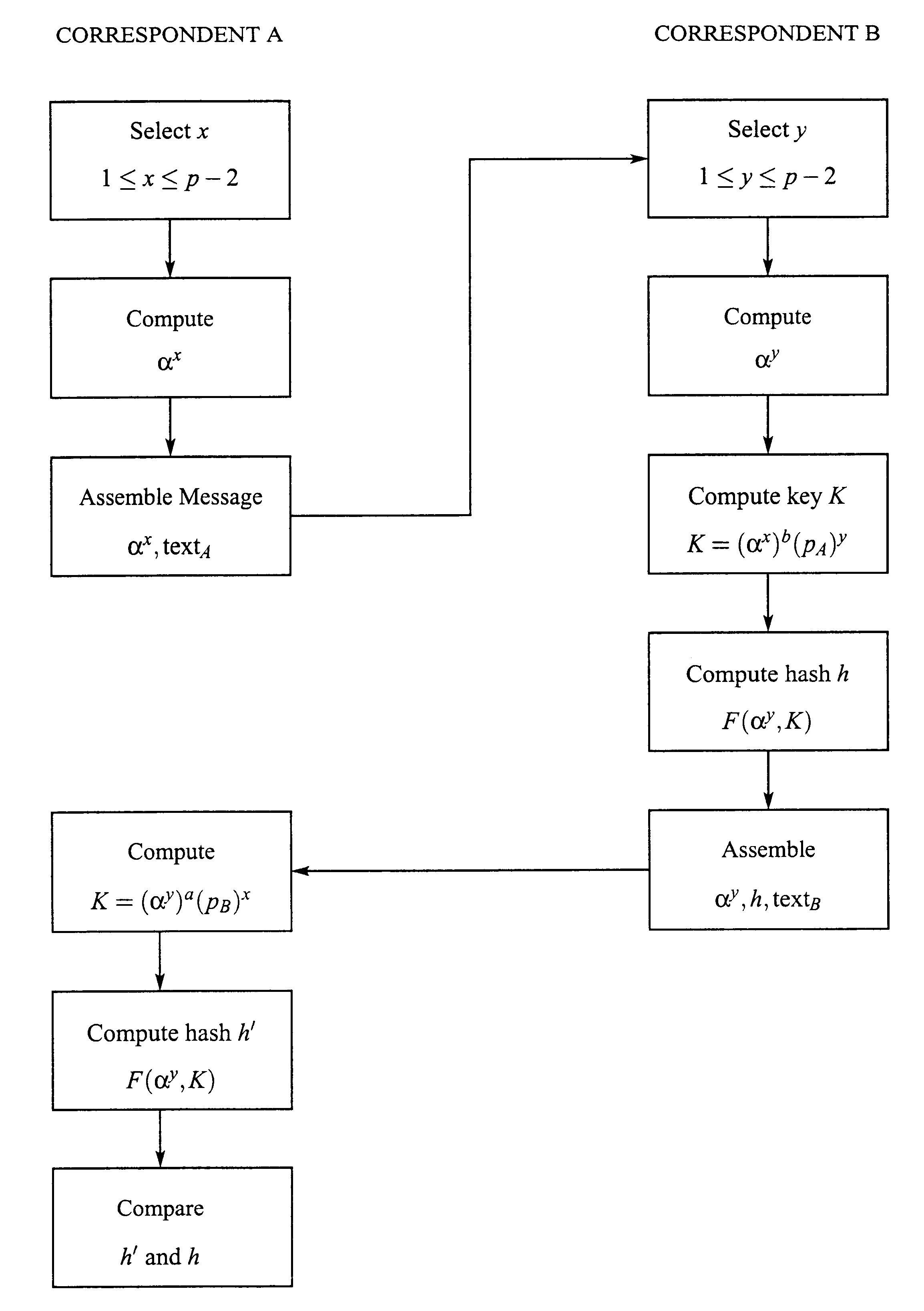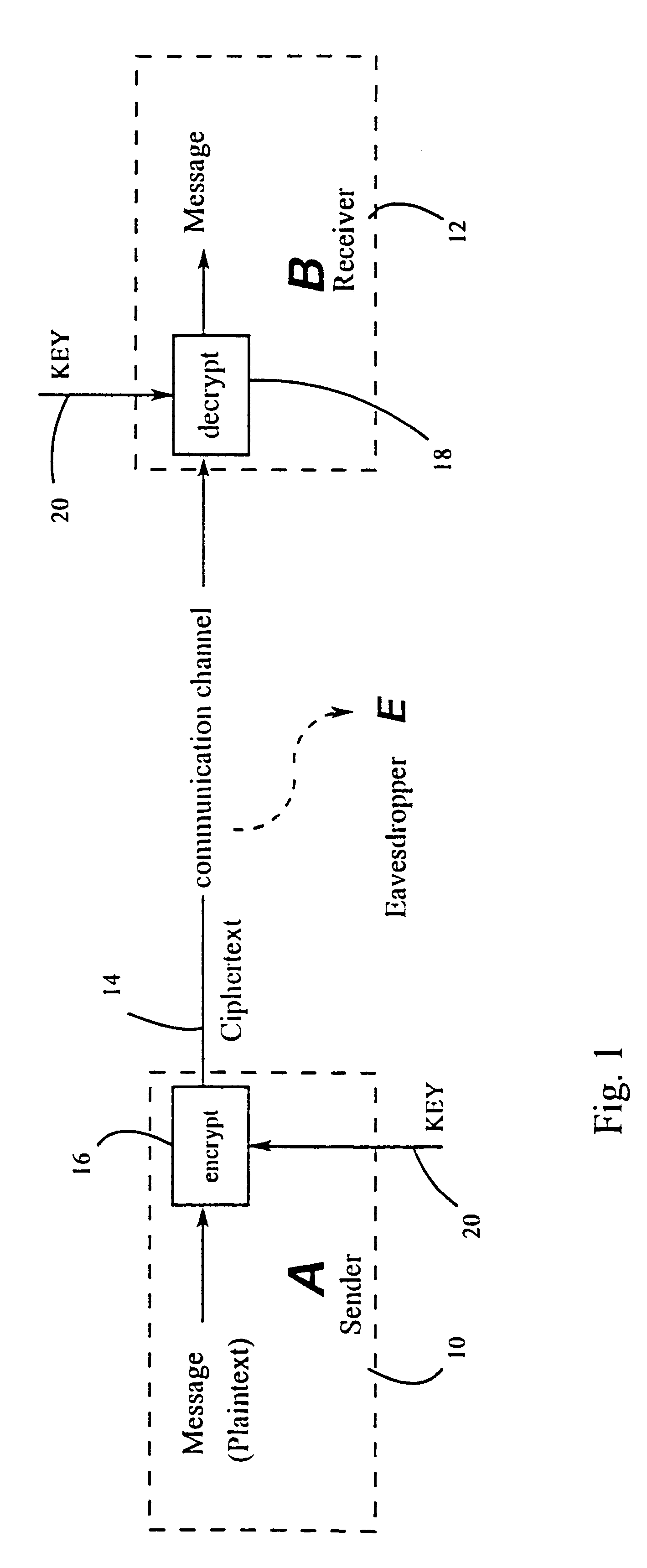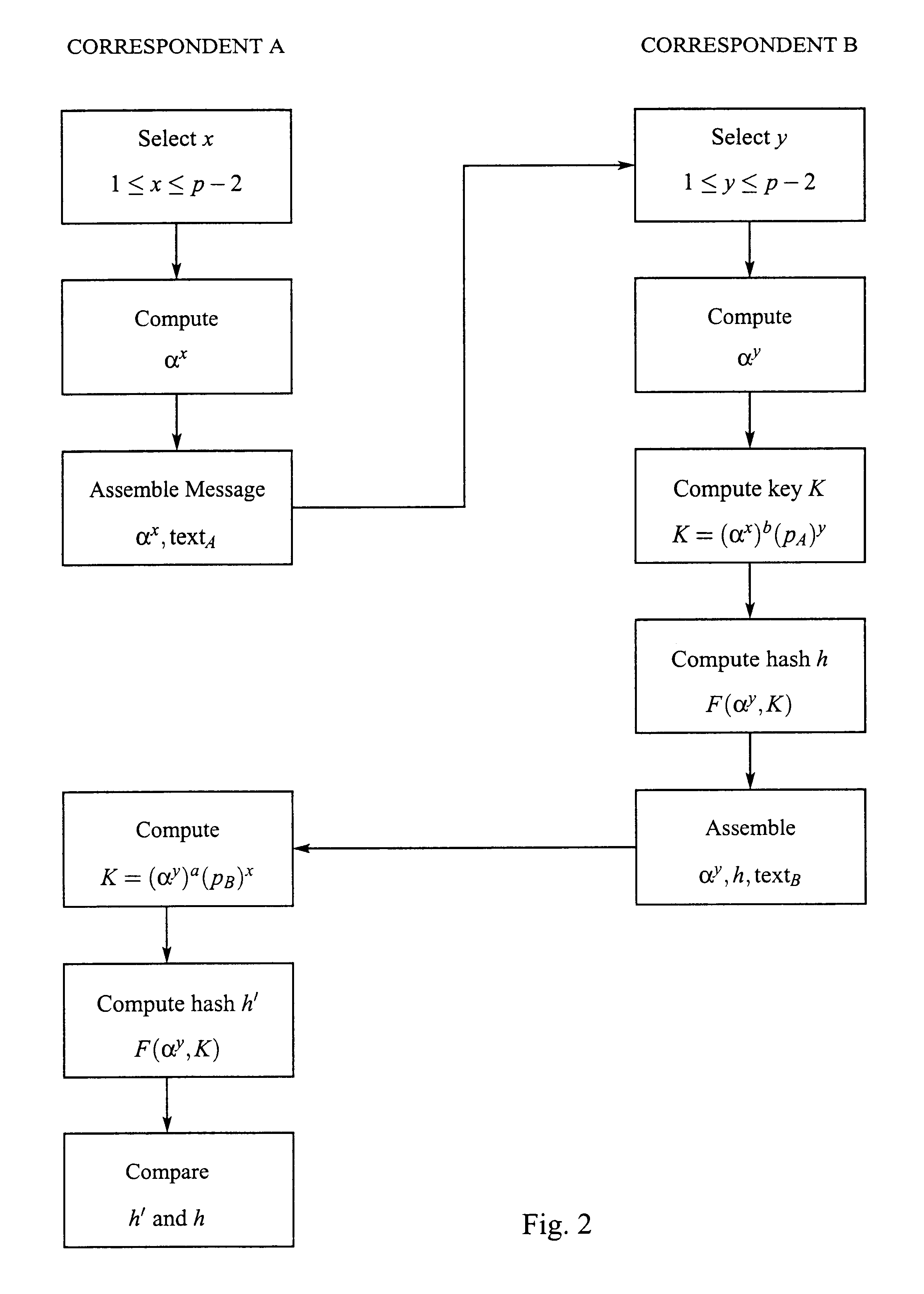Key agreement and transport protocol
a technology applied in the field of key agreement and transport protocol, can solve the problem that the interceptor cannot determine the contents of the messag
- Summary
- Abstract
- Description
- Claims
- Application Information
AI Technical Summary
Problems solved by technology
Method used
Image
Examples
example 2
MTI / B0 Protocol
In this protocol,
1. A generates a random integer x,1.ltoreq.x.ltoreq.p-2, computes (p.sub.B).sup.x =.alpha..sup.bx, and sends {.alpha..sup.bx,text.sub.A } to party B.
2. B generates a random integer y,1.ltoreq.y.ltoreq.p-2, computes (p.sub.A).sup.y =.alpha..sup.ay, and sends {.alpha..sup.ay,text.sub.B } to party A.
3. A computes K=(.alpha..sup.ay).sup.a.sup..sup.-1 .alpha..sup.x =.alpha..sup.x+y
4. A computes K=(.alpha..sup.bx).sup.b.sup..sup.-1 .alpha..sup.y =.alpha..sup.x+y
This protocol is vulnerable to the interloper E if,
1. E replaces A's message {.alpha..sup.bx,text.sub.A } with {.alpha..sup.bx,text.sub.B } to identify herself as the originator to the message.
2. B sends {(p.sub.E).sup.y,text.sub.E } to E, who then computes ((p.sub.E).sup.y).sup.e.sup..sup.-1 =.alpha..sup.ay and forwards {.alpha..sup.ay,text.sub.E } to A.
3. A computes K=(.alpha..sup.ay).sup.a.sup..sup.-1 .alpha..sup.x =.alpha..sup.x+y
4. B computes K=(.alpha..sup.bx).sup.b.sup..sup.-1 .alpha..sup.y =....
example 3
MTI / CO Protocol
This protocol operates as follows:
1. A generates a random integer x,1.ltoreq.x.ltoreq.p-2, computes (p.sub.B).sup.x =.alpha..sup.bx, and sends {.alpha..sup.bx,text.sub.A } to party B.
2. B generates a random integer y,1.ltoreq.y.ltoreq.p-2, computes (p.sub.A).sup.y =.alpha..sup.ay, and sends, {.alpha..sup.ay,text.sub.B } to party A.
3. A computes K=(.alpha..sup.ay).sup.a.sup..sup.-1 .sup.x =.alpha..sup.xy
4. B computes K=(.alpha..sup.bx).sup.b.sup..sup.-1 .sup.y =.alpha..sup.xy
The interloper E may interpose her identity as follows:
1. E replaces A's message {.alpha..sup.bx,text.sub.A } with {.alpha..sup.bx,text.sub.E }.
2. B sends {(p.sub.E).sup.y,text.sub.E } to E, who then computes ((p.sub.E).sup.y).sup.a-1 =.alpha..sup.ay and forwards {.alpha..sup.ay,text.sub.B } to A.
3. A computes K=(.alpha..sup.ay).sup.a.sup..sup.-1 .sup.x =.alpha..sup.xy
4. B computes K=(.alpha..sup.bx).sup.b.sup..sup.-1 .sup.y =.alpha..sup.xy
5. A and B now share the key K, even though B believes he s...
example 4
MTI / C1 Protocol
In this protocol:
1. A generates a random integer x,1.ltoreq.x.ltoreq.p-2, computes (p.sub.B).sup.ax =.alpha..sup.abx, and sends {.alpha..sup.abx,text.sub.A } to party B.
2. B generates a random integer y,1.ltoreq.y.ltoreq.p-2, computes (p.sub.A).sup.by =.alpha..sup.aby, and sends {.alpha..sup.aby,text.sub.B } to party A.
3. A computes K=(.alpha..sup.aby).sup.x =.alpha..sup.abxy.
4. B computes K=(.alpha..sup.abx).sup.y =.alpha..sup.abxy.
E can act as an interloper an follows:
1. E replaces A's message {.alpha..sup.abx,text.sub.A } with {.alpha..sup.abx,text.sub.E }.
2. B sends {(p.sub.E).sup.by,text.sub.B } to E, who then computes ((p.sub.E).sup.by).sup.e-1 =.alpha..sup.aby and forwards {.alpha..sup.aby,text.sub.B } to A.
3. A computes K=(.alpha..sup.aby).sup.x =.alpha..sup.abxy.
4. B computes K=(.alpha..sup.abx).sup.y =.alpha..sup.abxy.
5. A and B now share the key K, even though B believes he shares a key with E.
To avoid this, the protocol is modified an follows:
1. A generate...
PUM
 Login to View More
Login to View More Abstract
Description
Claims
Application Information
 Login to View More
Login to View More - R&D
- Intellectual Property
- Life Sciences
- Materials
- Tech Scout
- Unparalleled Data Quality
- Higher Quality Content
- 60% Fewer Hallucinations
Browse by: Latest US Patents, China's latest patents, Technical Efficacy Thesaurus, Application Domain, Technology Topic, Popular Technical Reports.
© 2025 PatSnap. All rights reserved.Legal|Privacy policy|Modern Slavery Act Transparency Statement|Sitemap|About US| Contact US: help@patsnap.com



